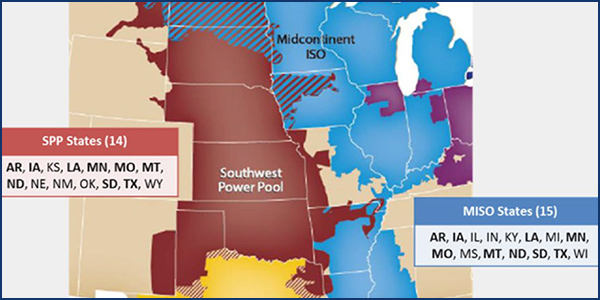Regulators hailing from SPP’s and MISO’s footprint would like to see the grid operators improve seams relations by resolving rate pancaking and adding a smaller interregional project category.
The MISO-SPP Seams Liaison Committee (SLC), comprised of regulators from the Organization of MISO States (OMS) and SPP’s Regional State Committee (RSC), agreed this week that the RTOs would best be served by addressing multiple transmission charges at their seam and creating a class of smaller cross-border projects similar to the Targeted Market Efficiency Projects (TMEPs) used by MISO and PJM.
The two items top the regulators’ draft list of seams recommendations. The regulators also designated current interconnection queue processes and interregional transmission planning efforts as medium priority.
The SLC relegated market-to-market improvements, developing an interface pricing process, and coordinated transaction scheduling to low priority status.
Texas Public Utility Commission Chair DeAnn Walker will share the draft list of recommendations with the RSC when it next meets on Jan. 25. She cautioned her fellow regulators that the draft document “could come out of the RSC looking much different,” as the committee has not been as involved as the OMS the last few months.
“I would like to get more concrete direction from the RSC as a whole,” she said during the committee’s call on Tuesday. “Maybe [RSC’s members] will provide a little bit more insight and clarity on this.”
“I would prefer Chairman Walker go to our RSC first,” RSC’s newly elected president Kristie Fiegen said. “We haven’t been able to discuss anything because we haven’t had a publicly noticed meeting [lately].”
Walker acknowledged that MISO and SPP are already working to address many of the topics, giving partial credit to the SLC. “We’ve done a lot in getting MISO and SPP to work together where there was probably a little bit of a roadblock before,” she said.
Missouri Public Service Commissioner Ryan Silvey said that while the OMS and RSC have agreed on the majority of the recommendations, differences on issue prioritization are because the RTOs already have plans in place to make improvements.
Walker said tackling transmission rate pancaking between MISO and SPP is the most “controversial” recommendation because it would require significant member agreement and stakeholder votes to come to a solution.
“I think there are a lot of members who would like to see this move forward, but there are just as many who wouldn’t,” she said. A pancaking solution could potentially result in “years of drawn-out litigation,” she said, noting multiple Texas utilities have litigious histories.
“I don’t see them being docile,” Walker warned.
The SLC may put together a working group to address rate pancaking between MISO and SPP.
“What I hope this will turn into is a negotiation that turns into an agreement first with the [transmission owners] and spreads to other members,” Arkansas Public Service Commission Chairman Ted Thomas said late last year.
OMS and RSC also recommended the grid operators use the TMEPs study category, which MISO and PJM use to identify smaller transmission projects that ease historical congestion along the seams.
Last year, regulators appeared split over whether MISO and SPP should embark on their own TMEP process. Some MISO South regulators have maintained that the seam isn’t mature enough to benefit from congestion-relieving TMEPs.
Others said a similar process — not an exact replica — could work.
“I don’t know that we need to get tangled up in exactly the same specific study process, but that we have one that accomplishes the same study objectives,” North Dakota Commissioner Julie Fedorchak said last year.
MISO and SPP have never approved a major interregional transmission project. Some in the MISO stakeholder community have suggested TMEPs as a route to alleviate some cross-border congestion.
Having finalized its recommendations, the committee may now transition to a monitoring role on MISO-SPP seams issues and hold less frequent meetings. Commissioners noted that the OMS is advisory in nature while the RSC has specific oversight bylaws. Some said the difference could limit how the committee issues guidance going forward.





